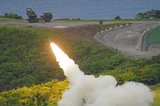MDA selects two teams for Next Generation Interceptor development
The Next Generation Interceptor will supersede the Ground-based Midcourse Defense system (pictured) in the US. (Photo: MDA)
Teams led by Lockheed Martin and Northrop Grumman each received contracts on 23 March from the US Missile Defense Agency (MDA) to design the Next Generation Interceptor (NGI).
Lockheed Martin is partnered by Aerojet, while Northrop Grumman is teamed with Raytheon.
The contract for both teams, including flight test options for the new long-range missile defence system, will be completed by 2029.
The aim is to protect the US against intercontinental ballistic missile threats in the 2030s.
Neither Northrop Grumman nor Raytheon disclosed the value of their NGI development contract, although the DoD on 23 March announced it is worth $3.93 million. Lockheed Martin disclosed that its deal is valued at $3.7 billion.
In May 2020, the DoD launched a competition for NGI, in search of a new guided missile and warhead as an improvement on the existing Ground-based Midcourse Defense (GMD) system in the US.
Incumbent GMD contractor Boeing has not been selected for NGI. Raytheon and Aerojet manufactured the kill vehicle for GMD, while Lockheed Martin stated that it will apply its experience on THAAD and the USN Trident programme to NGI.
This article was amended on 24 March with the contract value for Northrop Grumman.
As part of our promise to deliver comprehensive coverage to our Defence Insight and Premium News subscribers, our curated defence news content provides the latest industry updates, contract awards and programme milestones.
More from Defence Notes
-
![How might European countries look to tackle drone incursions?]()
How might European countries look to tackle drone incursions?
Disruption of infrastructure in Europe, whether by cyberattack, physical damage to pipelines or uncrewed aerial vehicles flying over major airports, as has happened more recently, is on the rise. What is the most effective way of countering the aerial aspect of this not-so-open warfare?
-
![Taiwan approved for $11 billion weapon purchase from US]()
Taiwan approved for $11 billion weapon purchase from US
The US State Department’s approval of a multi-billion-dollar sale of weapons to Taiwan includes tactical mission networks equipment, uncrewed aerial systems, artillery rocket systems and self-propelled howitzers as well as anti-tank guided missiles.
-
![US National Security Strategy prioritises advanced military capabilities and national industry]()
US National Security Strategy prioritises advanced military capabilities and national industry
The 2025 NSS has emphasised investment in the US nuclear and air defence inventory and national industry, but it leaves multiple unanswered questions on how the White House will implement this approach.
-
![Canada set to look away from its neighbour and across the Atlantic for partners]()
Canada set to look away from its neighbour and across the Atlantic for partners
While non-EU UK struggles to join the Security Action for Europe initiative, which provides loans for defence programmes, Canada has become the first country outside Europe to get access – and did so for a nominal fee.
























